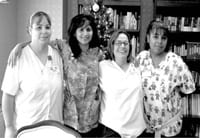All Changes, Great And Small Loomis House Continues On Its Journey Toward Culture Change In Long-term Care
Their names are ‘Sox’ and ‘Charlie,’ and they have their own wing at Loomis House, a retirement community in Holyoke, furnished with comfortable beds and a wide array of toys.
Two of the youngest residents at Loomis House, Sox – a gray long-hair cat and Charlie, his orange tabby companion – are regular fixtures at the retirement community, and also represent two examples of shifting attitudes in long-term care. Increasingly, extended care facilities are making changes to their practice models to move away from largely impersonal, clinical environments and more toward a home away from home.
Lori Todd, administrator at Loomis House for the past eight years, said Loomis has undertaken a number of culture changes in the last four years, all aimed at creating a more positive, home-like environment for both residents and staff while maintaining high levels of personal and medical care for residents.
Some of the changes are small, like ‘Sox’ and ‘Charlie.’ Others are more wide-ranging, such as a major reorganization of staff that created permanent positions within specific areas of the hospital, and forged greater relationships between Loomis House employees, residents, and their families.
Large or small though, the changes are ongoing and gradual, Todd said, often referring to the process at Loomis as a “journey.”
The People in Your Neighborhood
Rather than trying to institute several major initiatives at once, Loomis House has instead been focused on slowly adding new or revamped practices to the retirement community’s repertoire, everything from renaming hallways ‘avenues’ to creating new positions and responsibilities for existing staff. And its work is garnering some attention – in 2004, Loomis House was awarded the Mass. Aging Assoc. Program Innovation of the Year Award, and it continues to receive recognition from other professional organizations such as MassPRO.
The most visible proof of the changes at Loomis are the facility’s ‘neighborhoods,’ which serve as home to various groups of residents and include core groups of permanent staff.
Todd explained that those hallways, which have been given street names like Harmony Hill, are just one small aspect of the neighborhood project.
“Some of our CNAs (certified nursing assistants) have been promoted to the position of ‘neighborhood coordinator,’ and that is a very different level,” said Todd.
The neighborhood coordinators oversee their neighborhood, serve as family liaisons, and complete some very specific educational components – learning about proper skin care for residents or how to handle a fall for instance.”
They are also in charge of reviewing and updating ‘care cards’ for each resident regularly – cards that list a residents’ specific medical and daily care needs.
Christine Carney-Letendre, director of nursing at Loomis, said the change did more that promote four CNAs – it created a new structure that has improved employee morale, work process, and organization.
“The work of the neighborhood coordinators is vast,” she said. “They handle staffing, scheduling, evaluations, corrective actions … they’re a new set of eyes with the specific responsibility of taking care of their neighborhood, whereas before the coordinators were put into place, there was one senior nursing assistant who could oversee a little, but not at this level.”
Study Halls
Todd said she and her staff aren’t following any specific models or programs to initiate changes like the neighborhoods at Loomis, although there are several nationwide to choose from. Instead, they are gleaning ideas from various programs that have proven effective in other facilities, and continuing education is a big part of the plan.
“We began our journey after receiving ECCLI (Extended Care Career Ladder Initiatives) grants for education,” she said, “and education has remained an important part of the equation.”
Nursing staff, including RNs, LPNs, and CNAs, regularly leave the facility to attend professional development courses, for instance, a practice that not only helps the staff develop new skills, but also keeps their jobs engaging.
“It helps us guard against burnout, because they’re stepping away from their daily duties and getting refreshed,” she said.
And educational endeavors don’t end at the clinical level. One of the most effective models for change at Loomis originated at a session for administrators with Bill and Judy Thomas, creators of the Eden Alternative, a popular vehicle for change within long-term care communities.
“Eden has been an incredible part of our journey,” said Todd. “We aren’t using a template for change by any means, but several of the Eden principles have been incorporated at Loomis to create specific changes.
“Every time we try to make a change we ask these questions: ‘Will this promote personal growth?’ and ‘Are these decisions taking the needs of the residents into account as much as possible?’” Todd continued. “It’s part of a major press to change the overall culture here and in the long-term care industry, and for us, these changes are here to stay.”
She added that across the country, long-term care facilities are initiating similar changes, as part of a new revolution in the industry meant to improve overall practices as well as the public’s perception of retirement, assisted living, and nursing facilities.
“We’re not an industry that has seen a lot of good press,” Todd said. “We’re trying to change the public’s view of us, and the only way we can do that is by initiating effective change in our industry across the board.”
For Loomis House, that has meant a number of changes both small and large, but moreover it has required a concerted effort on the part of staff at all levels to embrace those changes, and in many cases on the part of residents’ families, too.
“Families need to partner in order for us to provide the best care,” she said.
In addition to the staff education, Todd said, Loomis is also gearing up to incorporate a series of new changes this year with the goal of creating increasingly home-like environments in all areas.
A Four-legged Approach
An already restaurant-style dining commons, for example, will soon include a buffet bar and a larger selection of ‘grab and go’ foods, so residents will feel more comfortable taking meals or snacks on their own schedules.
The bathing suites are also slated to receive some ‘spa-level’ improvements, Todd said, and Sox and Charlie have been given free reign of the neighborhood avenues, quietly patrolling or sitting with residents feeling ill.
“Sometimes, small things go a long way, ” Todd said.
Jaclyn Stevenson can be reached at stevenson@healthcarenews.com


